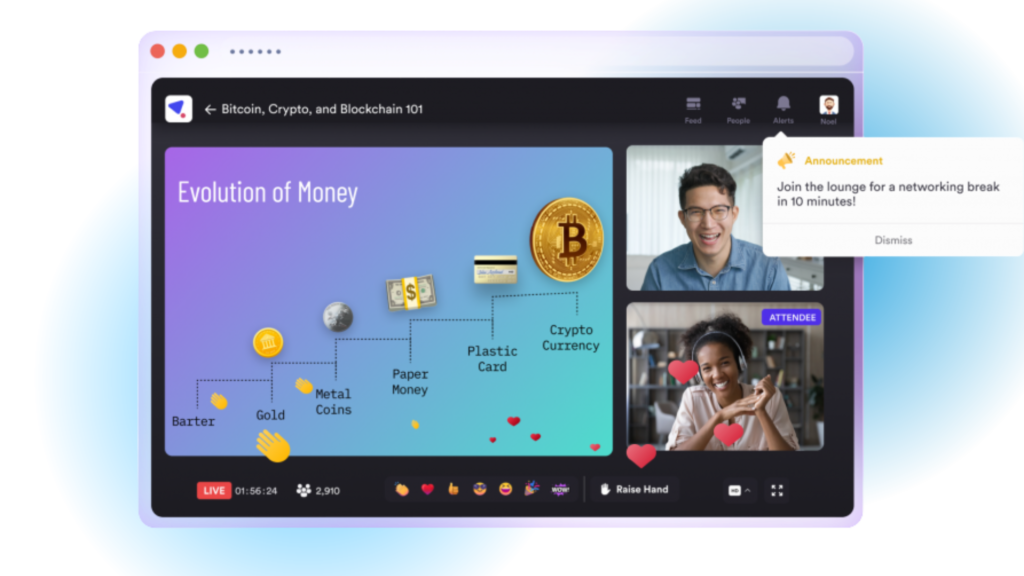The online learning revolution is rumbling onwards. Virtual classrooms open up lessons to students anywhere in the world. If you’re someone looking to know everything there’s need to know about a virtual classroom, and tips to keep your students engaged online, this article will take you to zero to hero in a couple of minutes.
So lend me your webcams (and ears!)
In this article, you’ll learn:
- What is a virtual classroom?
- What are the benefits and drawbacks of a virtual classroom?
- How to set up a virtual classroom
- How to boost online student engagement in a virtual classroom
- Ideas to keep up online student engagement in a virtual classroom
- Top 5 platforms for online learning and virtual classrooms
- Explore Airmeet’s virtual classrooms
- Final thoughts
What is a virtual classroom?
Virtual classrooms shift the learning experience from in-person to online. They’re online platforms where teachers can deliver lessons, share materials, and set assignments. Students can access content, collaborate with peers, and receive one-to-one support.
What are the benefits and drawbacks of a virtual classroom?
The rise of virtual classes flipped a centuries-old industry on its head. But distance learning and virtual classrooms aren’t silver bullets to the education industry’s woes. It’s way more nuanced than that.
Virtual classrooms have benefits and drawbacks. It’s up to you, as a teacher or education leader, to decide what’s best for your learners.
Here are the main benefits and drawbacks to consider:
|
Virtual classroom benefits |
Virtual classroom drawbacks |
|
Do your students live hundreds of miles away from a school? Don’t worry about it. Anyone with an internet connection can attend a student virtual classroom. |
Students have fewer opportunities to socialize outside of class. Schools and colleges aren’t just about learning. Students meet peers, forge friendships, and develop social skills. |
|
No more commutes and classroom changes mean greater flexibility and efficiency. Reclaim wasted time and maximize your teaching resources. With virtual classrooms, you can even share educators between locations. |
If your (or your students’) internet connection is unreliable, your classroom experience will suffer. Internet speeds and reliability are improving all the time, but some people, particularly in rural communities, lack strong connections. |
|
Digital tools deliver a more personalized learning experience. Advanced systems create individual feedback loops, assessing students in real time and presenting them with harder or easier work. |
Students can’t enjoy campus facilities because they’re not there. If students study from home, they can’t access typical campus facilities like gyms, libraries, and cafeterias. |
|
Virtual classroom platforms include accessibility features as standard. Real-time transcription, automatically generated closed captioning, screen readers, text-to-speech — it all lives natively within the technology. They support different learning styles and allow asynchronous learning. |
When students are in a physical classroom, it’s easy (or easier, at least) for them to stay switched on. On the other hand, when they’re staring at a screen all day, it’s a lot harder for them to maintain their concentration. |
|
Virtual classrooms are significantly cheaper than physical ones. Nix your rent, heating, electricity, and transport costs without compromising on teaching standards. |
Student virtual classrooms can’t support every lesson. You can teach math, English, and history online, but what about woodworking or painting? Experiential subjects are much harder to teach virtually. |
What are the types of virtual classrooms?
Primarily, there are four types of virtual classrooms, each with its own unique features and advantages.
- Synchronous virtual classrooms: Real-time interaction between teachers and students.
- Asynchronous virtual classrooms: Access to pre-recorded lectures, assignments, and discussions on students’ own time.
- Hybrid virtual classrooms: Combination of both synchronous and asynchronous methods of teaching.
- Augmented reality virtual classrooms: Use of augmented reality technology to enhance the learning experience.
What are the functions of a virtual classroom?
The primary function of a virtual classroom is to facilitate remote learning, enabling teachers and students to communicate and collaborate in real time from anywhere with an internet connection.
Overall, some key functions of a virtual classroom include:
- Live communication between teachers and fellow classmates.
- Collaborative learning and problem-solving.
- Access to course materials.
- Assessment and feedback tools.
- Convenience and flexibility.
How to set up and create a virtual classroom
Whether you’re a seasoned pro or an online teacher newbie, setting up a virtual classroom can be a walk in the park… if you’ve got the right workflow.
In this section, we’ll guide you through the entire setup process — from selecting the right technology to designing a student feedback system.
#1 Choose a virtual learning platform
Your virtual classroom technology is your foundation. If it’s robust and reliable, you’ll do well. If it’s cruddy, you’ll spend more time fighting with the setup than delivering your lessons. Consider factors such as ease of use, compatibility, and security.
#2 Define learning objectives
Great lessons have a purpose — whether they’re in a traditional classroom environment or online. Set your learning objectives early and build from there.
#3 Create content and materials
Since you’re teaching in a digital learning environment (also called a remote learning environment), incorporate as much multimedia content as you can — YouTube videos, images, Google Slides, illustrations, gifs, the list goes on.
#4 Set up online assessments
Old-school tests are slow and laborious. By the time a student gets their results, they’ve already forgotten about the content. Choose a digital assessment service that works in real time so they can learn, verify their knowledge, and correct any mistakes during a single lesson.
#5 Design your presentation space
If you’re working from home, create a dedicated presentation space with a neutral, clutter-free background.
#6 Check your equipment
crackle
static
silence
We’ve all been there. Unplugged microphones, malfunctioning webcams, lagging video, crackly audio.
Before you start, double-check all your equipment. Make sure your internet connection is strong and stable, your webcam is working (and the lens is cleaned), and your microphone is picking up your audio.
#7 Develop student guidelines
Physical classrooms have a bunch of unwritten rules. How do you ask a question? When can you go to the bathroom? What do you do if you don’t understand something? How do students ask you to clarify concepts?
Before you start online lessons, create some basic student guidelines. Cover all the unwritten in-person rules along with guidelines for technology, collaboration, and attendance.
#8 Communicate with students
When students arrive in your virtual classroom, they should be ready to rock and roll. Before you start, communicate with your students — a lot. Send email reminders about technology and lesson overviews. Send them advice on how to set up their laptops and what they’ll need for group work.
#9 Conduct a trial run
In-depth plans are good… but actual experience is better. Conduct a trial run of your virtual lesson with teachers or a handful of willing students to make sure everything’s running smoothly. Also, ask for feedback: What worked well? Where do you need to improve?
#10 Continuously evaluate and improve
No one launched the perfect virtual classroom the first time. Chances are, you’ll have niggles and mistakes and issues. Use each lesson as an opportunity to improve. Keep asking students for feedback and make small adjustments to improve their learning experience.
How to boost online student engagement in a virtual classroom
Perhaps the biggest challenge to virtual learning is student engagement. It’s tough to grab and hold students’ attention when you’re just a floating head on their laptop screens.
But there are a few things you can do to turn the dial on online student engagement, earn your students’ attention, and create immersive lessons.
Here are some of our favorite tactics for how to keep students engaged in a virtual classroom.
Effortless collaboration and networking
One-way presentations like video lectures or presentations get boring fast. Split classes into smaller groups and set tasks, assignments, and exercises. Changing up the dynamic keeps lessons feeling fresh and encourages online student engagement.
Plus, students get to socialize and work with each other — a huge part of any school or college experience.
Emotional connection
Students won’t focus on dry lessons and bland study materials. According to the HAAAM framework, students need to feel one of five specific emotions in order to connect with a topic or experience. The five emotions are:
- Hopeful
- Adventurous
- Active
- Accepted
- Motivated
If you evoke one of those emotions, you stand a much better chance of keeping your students engaged during lessons.
Live activities
Another way to break up a one-way presentation is via live activities. Unlike group work, live activities allow teachers to keep control and focus while engaging individual students.
Here are some ideas:
- Group icebreakers: Kickstart new courses, classes, and semesters with icebreakers. Show and tell, pictionary, and two truths and a lie are all popular options.
- Host polls and Q&As: These let students test their knowledge during lessons. They also let teachers gauge a class’s understanding of a topic.
- Digital scavenger hunts: Test your students’ self-directed learning with individual or team scavenger hunts.
Gamification
Use gamification to celebrate small wins, accelerate learning progress, and cultivate student engagement. This works best when it’s included in your e-learning or virtual classroom technology. You can award experience points or achievements for completing modules or let groups compete against each other in quizzes and tests.
Just be careful not to ramp up the pressure too much. You want to inspire learners to try harder, not demoralize them for going slow.
Ideas to boost online student engagement in a virtual classroom
Mix synchronous and asynchronous learning
When it comes to engaging students online, it’s best to give students room to absorb and learn key concepts asynchronously at their own pace. Using a synchronous virtual classroom for stimulating activities like solving problems in a peer group, resolving doubts, and revising concepts while keeping the asynchronous discussions and learnings to explain concepts can be a better way to engage students.
Creating an online forum to build an active community
A sense of community and belonging can be the key to online student engagement. While traditional classrooms build interactions and communication organically, active forums that foster back-and-forth dialogue are needed for students to stay motivated to participate more in online learning.
Live feedback about assignments
Provide students with feedback on their work as soon as possible to help them improve and stay motivated. Without feedback, students may lose interest in online modes of learning.
Use learning management systems
Learning management systems (LMS) can keep online students engaged by providing easy access to course content, facilitating communication and collaboration, and providing tools for tracking progress and giving feedback. Additionally, incorporating gamification elements can motivate students and make the learning experience more enjoyable.
Use social media to spur online discussions and engagement
Most students spend a good amount of time on social media. Engaging them on channels where they naturally spend time can help keep your virtual classroom on top of the minds of students. Create course hashtags, share lesson snippets, and snapshots of virtual moments from your virtual classroom.
Gamification, challenges, and leaderboards
A healthy sense of competition can push students to be actively and organically driven to stay on top of their lessons and homework. Thus, add elements like leaderboards, fun games, and challenges to make online education more immersive and engaging.
Group icebreakers
Activities that help students get to know each other better and feel more comfortable in the virtual classroom.
Spin the wheel
Use a digital tool to randomly select students for participation or assign tasks to keep things interesting.
Use GIFs and jokes
Add humor to presentations to keep students engaged and interested.
Host polls and Q&A
Ask students questions and allow them to give feedback to help improve the learning experience.
Digital scavenger hunts
Give students a list of items or tasks to complete to help reinforce concepts and keep them engaged.
Would you rather game
Present students with two options and ask them to choose which one they would rather do to encourage critical thinking.
Virtual trivia
Ask students questions on a particular topic to make your virtual class more fun and engaging.
Breakout rooms for challenges
Use breakout rooms to foster stimulating student discussions, boost student participation, and encourage collaboration and teamwork.
Use an online whiteboard
If you want to boost online student engagement, consider using an online whiteboard in your virtual classroom. It’s a great tool for facilitating real-time collaboration, visual learning, and interactive problem-solving.
Top 5 platforms virtual classroom platforms for online student engagement
The tech space is booming right now. Every year there are more and more software options on the market to host your next virtual class.
But what virtual classroom tech is best?
Let’s take a look at the top five players.
Zoom One
Before the pandemic, Zoom was a niche communication product. Now, it’s a synonym for video chat. A lot of schools and colleges opted for Zoom early in the pandemic but found it lacked core teaching features. While Zoom One (its integrated product that features chat, phone, whiteboard, and meetings) has done a lot to fill the gaps, schools and colleges may want a more specialist educational product.
Webex Meetings
Another goliath in the video conferencing space, Webex promises a robust platform, which is particularly attractive to larger organizations. Robust privacy (FERPA and COPPA compliance), hybrid support, and LMS integration are big pluses, especially for midmarket and enterprise clients.
Whereby
Whereby is another vendor that boomed during the pandemic. Unlike other tech providers, they offer two options: a standalone video tool like Zoom and an embedded service that you can integrate into other products. For organizations building their own bespoke learning environment, their embedded product is tough to beat.
Adobe Connect
Yes, we’re talking about Adobe. The design tech company’s video platform dates back to 2019 when it launched as a PowerPoint-to-Flash plugin. Since then, it’s developed into a robust virtual classroom platform. Good LMS integration, breakout rooms, and a focus on accessibility make Adobe Connect another popular choice.
Airmeet
Join the University of Arkansas, EdBrand, and Florida International University in selecting Airmeet as their virtual classroom platform. Access all the same features event professionals have been using for years — interactive elements, open lounges, multi-language support, the list goes on. Curious to learn more? We’ve got a deep dive on Airmeet up next.
Explore Airmeet’s virtual classrooms
While Airmeet made its name in virtual and hybrid corporate events, more and more educators are turning to the platform for online courses and learning. (the University of Toronto, New Jersey Institute of Technology, and Bradley University, to name just a few.
When you look at Airmeet’s feature list, it’s clear why:
- Educate at scale: Deliver sessions for one learner or 100,000 students with the same great experience.
- Bring learners on stage: Bring students on stage for questions, discussions, and live interaction.
- Breakout rooms and live chat: Let students talk to each other to encourage peer-to-peer learning. Allow for asynchronous communication with message boards.
- Social lounges: Give teams a dedicated space to work together on team activities and group assignments. Or turn it into a virtual cafe and let people hang out for some genuine human connection.
Throw in third-party integrations, deep session analytics, and in-built gamification, and Airmeet offers a great learning experience — for teachers, professors, and students.
Learn more about Airmeet’s educational pedigree here.
Final thoughts
In the early days of the online courses and learning revolution, schools and colleges focused on basic lesson delivery. Could they get teachers in front of students? Can students submit homework and assignments? But the basics are table stakes nowadays.
Today, educators must focus on classroom experience and student engagement. Are virtual classrooms captivating? Does your technology support people with disabilities? Can students easily collaborate, communicate, and socialize?
We believe Airmeet can allow teachers to take the next step and push beyond basic delivery to create a delightful learning environment. If you’re ready to take that step, get in touch with one of our specialists today.
















